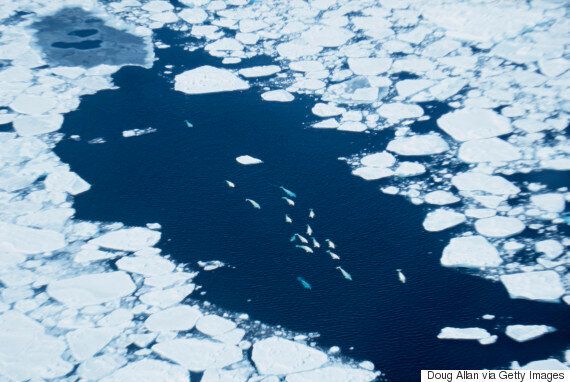
Aerial view of a pod of beluga whales in Lancaster Sound, Canada. (Photo: DOUG ALLAN VIA GETTY IMAGES)
Written by Bettina Saier, Vice President, Oceans
Barack Obama's presidency is going out with a splash.
In August, Obama expanded the Papahānaumokuākea Marine National Monument near Hawaii to 1,510,000 square kilometres. That's about the size of Quebec, Canada's largest province, making it the Earth's largest protected area, in land or at sea. On September 15, he announced the creation of the Northeast Canyons and Seamounts Marine National Monument, America's first Atlantic marine monument. This latest area is smaller, but also closer to shore and therefore used more intensively. The monument will protect biologically significant areas, including the habitats of deep-sea coral, whales and critically endangered sea turtles.
He made the Northeast Canyons and Seamounts announcement at the U.S. Department of State's Our Oceans conference -- and remarkably, that wasn't the only big announcement to occur. Britain announced it would ban commercial fishing in a marine protected area (MPA) around Pitcairn island, creating a "no-take zone" of 1 million square kilometres. The European Union announced it was halfway to its goal of 10 per cent marine protection by 2020. Chile spoke of its success with the marine protected area it created in 2015, one the size of Italy.
All told, 20 countries lined up the announce the creation of 40 new marine protection areas, totalling 1.2 million square kilometers, aimed at protecting the ocean from threats like overfishing and pollution.
Protecting Lancaster Sound, an area twice the size of Nova Scotia, will more double the ocean space protected by Canada.
Canada has its own commitments to live up to: to protect five per cent of Canada's marine territory by 2017 and 10 per cent by 2020. We know we can get there. We just need to get going.
For instance, now that oil rights near Lancaster Sound in the Arctic have been relinquished, the marine protected area that the community has been demanding for 40 years can be expedited. Protecting Lancaster Sound, an area twice the size of Nova Scotia, will more double the ocean space protected by Canada.
To help illustrate what else could happen in terms of marine protection, WWF-Canada has created this interactive map highlighting proposed Marine Protected Area sites with information about existing MPAs.
But it's not just about the target number: MPAs have to offer meaningful protection, too. Take a deeper dive into Marine Protected Areas and find out what science tells us about the kinds of ocean protections are most effective.
International expectations have been raised now that the United States has become serious about marine protection, and WWF-Canada applauds this global sea change. If Canada makes good on its targets, we can expect MPA announcements to start coming quickly in the coming months.
Follow HuffPost Canada Blogs on Facebook
Also on HuffPost:
